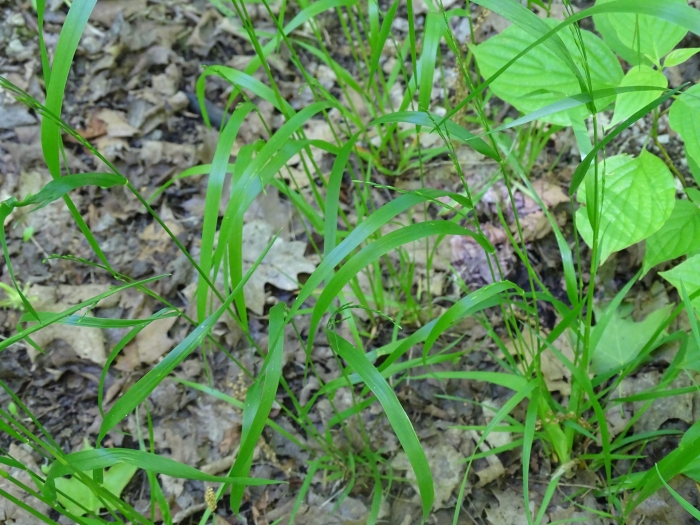Black-Fruited Rice Grass
(Oryzopsis racemosa)
Black-Fruited Rice Grass (Oryzopsis racemosa)
/
/

Reuven Martin
Public Domain
Image By:
Reuven Martin
Recorded By:
Copyright:
Public Domain
Copyright Notice:
Photo by: Reuven Martin | License Type: Public Domain | License URL: http://creativecommons.org/publicdomain/zero/1.0/ | Rights Holder: Reuven Martin | Publisher: iNaturalist | Date Created: 2019-06-08T12:39:39-07:00 |













































Estimated Native Range
Summary
Oryzopsis racemosa, commonly known as Black-Fruited Rice Grass, is a perennial grass that exhibits evergreen or semi-deciduous characteristics. It is native to a variety of habitats including dry sandy or gravelly soils, open woods, clearings, pine barrens, and wooded slopes in Eastern North America. This grass typically grows to a height and width of 1-3 feet (0.3-0.9 meters), forming dense tufts of fine-textured foliage. The inflorescences are subtle, with the dark-colored grains giving the plant its common name. Flowering occurs in late spring to early summer, and while the flowers are not particularly showy, they add a fine-textured element to the landscape.
Black-Fruited Rice Grass is valued for its adaptability to a range of soil conditions and its ability to thrive with minimal care, making it a suitable choice for naturalistic plantings and restoration projects. It is often used in wildflower meadows, as a ground cover, or for erosion control on slopes. This grass prefers part shade to full sun and requires low amounts of water once established, making it a drought-tolerant option. It is also appreciated for its contribution to biodiversity, providing habitat and food for wildlife. While generally low-maintenance, it can be susceptible to rust diseases under certain conditions.CC BY-SA 4.0
Black-Fruited Rice Grass is valued for its adaptability to a range of soil conditions and its ability to thrive with minimal care, making it a suitable choice for naturalistic plantings and restoration projects. It is often used in wildflower meadows, as a ground cover, or for erosion control on slopes. This grass prefers part shade to full sun and requires low amounts of water once established, making it a drought-tolerant option. It is also appreciated for its contribution to biodiversity, providing habitat and food for wildlife. While generally low-maintenance, it can be susceptible to rust diseases under certain conditions.CC BY-SA 4.0
Plant Description
- Plant Type: Grass
- Height: 1-3 feet
- Width: 1-3 feet
- Growth Rate: Moderate
- Flower Color: N/A
- Flowering Season: Summer
- Leaf Retention: Evergreen
Growth Requirements
- Sun: Part Shade, Full Sun
- Water: Low
- Drainage: Medium, Fast
Common Uses
Erosion Control, Low Maintenance
Natural Habitat
Dry sandy or gravelly soils, open woods, clearings, pine barrens, and wooded slopes in Eastern North America
Other Names
Common Names: Black-Seeded Mountain-Rice Grass
Scientific Names: , Oryzopsis racemosa, Patis racemosa, Piptatherum racemosum, Oryzopsis melanocarpa, Milium racemosum, Piptatherum nigrum, Urachne melanosperma, Urachne racemosa,
GBIF Accepted Name: Oryzopsis racemosa (Sm.) Ricker ex Hitchc.